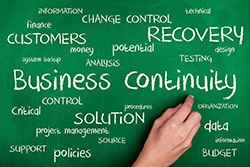 Statistics vary, but numerous sources state that 40% of businesses do not reopen after a disaster and another 25% fail within one year. Yet by being proactive you can better equip your business for survival.
Statistics vary, but numerous sources state that 40% of businesses do not reopen after a disaster and another 25% fail within one year. Yet by being proactive you can better equip your business for survival.
Understanding how your insurance coverage may or may not respond to your disaster is a critically important component of being #DisasterReady.
All insurance policies are not created equal. So it is necessary we open our coverage overview stating that there are different versions of policies, and it is advisable to read your policy carefully to fully understand exclusions and gaps in coverage.
For purposes of this blog, we are analyzing the impact of a disaster on your business continuity and assuming the appropriate property coverages are in place for the direct loss to your building and equipment.
Disaster is defined in many ways – and is very much dependent upon your critical business functions. Most people first think of tornadoes, floods, hurricanes, and fires. However, a disaster could also be as a key, vendor-hosted computer system going down, taking your business offline from your customers for days.
Simply stated, business income insurance is a type of insurance that covers the loss of income a business suffers after a disaster. But there’s that “disaster” word. Any of the above scenarios are likely “disasters” to the affected business. And any of them could cripple the business’ ability to respond to customers, leading to a loss of income. Are they all covered?
Fairly standard language for business income reads:
We will pay for the actual loss of “Business Income” and “Rental Value” you sustain due to the necessary “suspension” of your “operations” during the “period of restoration.” The “suspension” must be caused by direct physical “loss” to property at a “premises” caused by or resulting from any Covered Cause of Loss.
But what exactly does this mean? The words in quotations would all be defined in your policy. Let’s take a look at a few of them, as they are critical for this analysis:
Business Income means the:
- Net Income (net profit or loss before income taxes) that would have been earned or incurred; and
- Continuing normal operating expenses incurred, including payroll.
Suspension means:
- The slowdown or cessation of your business activities; and
- That a part or all of the “premises” is rendered untenantable.
Operations means your business activities occurring at the “premises.”
Loss means accidental loss or damage.
Premises means the Location of Premises described in the Declarations.
For our first example, the office operations of EFG Company at 1015 Main St are insured for standard property coverage including business income as highlighted above. An electrical fire starts overnight, destroying the building. EFG Company cannot respond to their customers until they get set up in a temporary facility, purchase furniture, and get computers up and running to restore their data from their backup.
Fire is a “covered cause of loss” in standard policies and meets the definition of “loss” as we have highlighted (sudden and accidental). In our scenario, we have also met the definitions of “suspension” and “operations.” EFG’s business has ceased and the premises is not tenantable. Given this scenario, EFG Company’s business interruption coverage would be triggered to provide relief for their lost income.
Let’s consider a different scenario. Still using EFG Company from our example above, what if a power substation 10 miles away explodes, leaving EFG Company without power for a week? During this time, EFG Company loses $100,000 of income. Have we triggered business interruption coverage? Analyzing the policy language and definitions again, they have a loss of income due to a “suspension” of their “operations.” The problem arises when we get to the definition of “premises.” Since the power failure occurred 10 miles away, coverage for the lost income is likely not triggered for EFG Company.
The key to understanding how your insurance coverage may respond is to undergo a risk assessment. This process can define what disaster(s) may affect your business. Then you can discuss with your agent how your current policy may respond and how you may be able to shore up any gaps in your current program.
In order to truly be #DisasterReady, you need to think about how your business will survive the disaster. So don’t overlook these critical steps in your disaster recovery planning!





